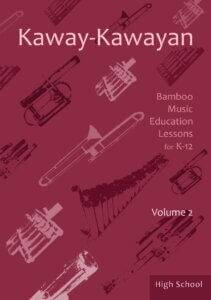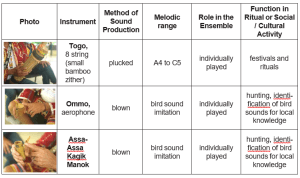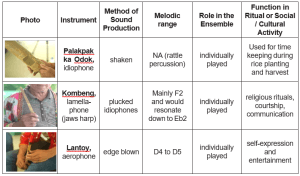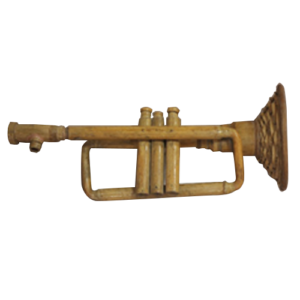Highschool Module
BAMBOO MUSICAL INSTRUMENTS OF BAGOBO-TAGABAWA IN DAVAO
Background
No content.

No content.
No content.
No content.
No content.
No content.
Excerpt from the BMI Ethnography of Bagobo-Tagabawa of Toril, Davao
“Pangdawet: Bagobo-Tagabawa Bamboo Music Instruments” By Yves P. Cuenza
The term “Bagobo” is a collective terminology that is being used among the Indigenous Cultural Communities/Indigenous Peoples (ICCs / IPs) of Southern Mindanao. This quasi ethnographic and instrumentation output will focus on bamboo musical instruments among the Bagobo-Tagabawa. “Tagabawa” is the name of a specific ethnic group that resides in both the flat plains and mountainous areas of Southern Davao. Their ethnic group name is derived from the word “Bawa” which means “the south.”1 Hence, they consider themselves the Bagobos of the south, more than the collective naming as simply “Bagobos” of Davao. Laura Watson Benedict was able to describe them in her article about this indigenous community, “. . .one of the groups of pagan Malays in southeastern Mindanao, Philippine Islands. Their habitat is on the eastern folds of the Cabadangan mountain-range, in the vicinity of Mount Apo, the highest peak, and on the foothills peak, and on the foothills then sloping down to the west coast of the Gulf of Davao.”2 This ethnographic project will primarily focus on the bamboo musical instruments of the Tagabawa people. They call it “pangdawet,” the term for music instruments in their own language. One of the most important contexts in understanding the music of indigenous Philippine music is to know how it functions with the society outside their community and how they interact with it. Tejero explained that:
The music of the cultural groups is tied closely to their community life. Music to them is not for entertainment. Rather, music has functions that are meaningful and indispensable to the tribes. The vocal and instrumental genres are identified according to their functions, which are usually connected with activities of the life cycle, agriculture, peace-pact making and curing of the sick.
The Bamboo Musical Instruments


End Notes:
- As explained by Karani Armando Bigcas during the FGD, May 4,
- Laura Watson Benedict, “Bagobo ” The Journal of American Folklore 26, no. 99 (1913): 13–63.
- Helen S. Tejero. “Music Translation: Giving Back to the People their Rich Musical ” JPAIR Multidisciplinary Research Journal 2, no. 1 (2009).
OBJECTIVES
A. Content Standards
Demonstrate understanding of the music of the Bagobo-Tagabawa ethnolinguistic group and analyze the music through performances, listening, musical mapping, and improvisation, and giving importance to the relevance of music in the culture.
B. Performance Standards
Perform examples of music from the Bagobo-Tagabawa, alone and with others, in appropriate tone, rhythm, and style.
C. Learning Competencies/Objectives
- Analyze the distinguishing musical characteristics, functions, and significance of bamboo music to the lives of the Bagobo-Tagabawa community.
- Explore other functions of music through improvisation, dance, and instrument playing.
- Play different bamboo musical instruments or improvised instruments following tunes and rhythmic patterns from the Bagobo-Tagabawa ethnolinguistic group.
- Improvise simple melodic and rhythmic patterns to accompany the music of the Bagobo-Tagabawa ethnolinguistic group.
CONTENT
A. Bamboo music of Bagobo-Tagabawa ethnolinguistic group
B. Social functions of music
- Music for entertainment
- Music for work
- Music for rituals
- Music for celebrations
C. Significance of music to the culture
(functional music, ritual music, dances, and songs)
D. Performance styles and techniques of bamboo music
LEARNING RESOURCES
A. References
1. Print Materials
- BMI ethnography on Bagobo-Tagabawa in Davao
- BMI documentation pictures of the Bagobo-Tagabawa people and bamboo instruments
2. Audio-Video Materials
- Videos from the BMI documentation

- Video of the Bagobo-Tagabawa tradition and culture
- Video of the Bagobo (dance with agung)
- Video of the Bagobo-Tagabawa youth dance
- Video of the gong music
- Video of the Bagobo-Tagabawa household
B. Other Learning Materials
- Available bamboo musical instruments from the Bagobo-Tagabawa ethnolinguistic group
- Improvised percussion instruments:
- Shaker (covered toilet paper cardboard rolls or plastic bottle with uncooked rice or mung beans inside)
- Drum (empty large tin cans) or any large plastic container
PROCEDURE
A. Reviewing the previous lesson or presenting the new lesson
- Show a picture of the community of Bagobo-Tagabawa ethnolinguistic group and ask the students to describe what they see, i.e., the patterns of the designs of the clothes, the colors that are prevalent, and the expression of the faces of the people in the picture.
- Play the video Bagobo-Tagabawa tradition and culture.
- Tell the students that the people of Bagobo-Tagabawa value their culture and tradition which they still practice today. Still prevalent in their community is the practice of traditions seen in everyday living, work, rituals, dances, lifestyle, and culture.
B. Establishing the purpose of the lesson
- Show a picture of the bamboo and materials that can be made out of it (house walls, fence, tools and musical instruments).
- Play the video Bagobo-Tagabawa household and show the significance of having such instruments, garments, and tools inside a household.
- Tell the students that these symbolize the Bagobo-Tagabawa culture that are highly valued.
C. Presenting examples/instances of the new lesson
- Watch the videos by the masters playing their bamboo instruments and Bagobo (dance with agung).
- Ask the students what the similarities on the functions of bamboo and gong music to the people of Bagobo-Tagabawa are.
- How can they translate what they hear through movements and music making using bamboo instruments or improvised musical instruments?
D. Discussing new concepts and practicing new skills no. 1
- Discussion on the previous videos watched:
- The Bagobo are classified into 3 groups namely the Tagabawa, Clata, and the Ubo. Literally, “Tagabawa” means from the south, which shows what area they are from. The other groups are situated near mountainous areas or near rivers. They have different languages, and they cannot understand what the other community speaks.
- Music is not limited to singing and playing but also is inseparable to dances, rituals, or even life at work. There are specific musical functions used during special occasions. Music has a significance in every aspect as it can be used for entertainment, courtship, or ritual.
- There are different bamboo musical instruments that are available (flute, zither, and jaw’s harp) which make melodic and rhythmic patterns which can accompany a song or a dance.
- Divide the class into groups with four to five members. The members should discuss what instrument they would like to play following the melodic and rhythmic patterns of the Bagobo-Tagabawa. Have a 3-minute presentation of a performance that has a musical instrument and dance similar to what they saw and heard in the previous videos shown.
E. Discussing new concepts and practicing new skills no. 2
- Watch a short clip: Bagobo-Tagabawa youth dance.
- Performance:
- Guide the students in listening to the video recordings and playing an instrument by ear.
- Brainstorm what social function they would like to do (celebratory dance, music that accompanies daily tasks or work) reflecting the culture of the Bagobo-Tagabawa.
- They may improvise on the use of different percussive and bamboo instruments.
F. Developing mastery (leads to formative assessment)
- Let the groups practice their presentation. Assign specific roles to each member. Instruct them to practice their chosen instrument.
- Have the group present a short performance (2–3 minutes) using their own melodic and rhythmic patterns to accompany a dance or a work routine.
- Assess the performance using teacher-made rubrics.
G. Finding practical applications of concept and skills in daily living
By listening and experiencing other cultures, how can we express our own ideas and manifest them in our daily lives?
H. Making generalization and abstraction about the lesson
Music is incorporated in every social aspect in life. Music can be used as a form of expression during courtship. It can also be used for entertainment during social gatherings. Music also shows the way of living of the community such as when it is used in rituals. Thus, music is an avenue to express culture. How can this knowledge be used to help in appreciating music and develop interest in learning how to play indigenous musical instruments?
I. Additional activities for application or remediation
Students who have more inclination in rhythmic patterns can play the percussion while dancing. Other students who are less able to maintain a steady tempo while playing rhythmic patterns can support the group by thinking of creative ways in performing their presentation.
REFLECTION
A. How many learners earned 80 percent in the evaluation? How many learners require additional activities for remediation?
B. Did the remedial lesson work? How many learners have caught up with the lesson? How many learners continue to require remediation?
C. Which of my teaching strategies worked well? Why did this work?
D. What difficulties can my principal or head teacher help me solve?
E. What innovation or localized materials did I use/discover which I wish to share with other teachers?
Science in a creative industry.
The DOST-FPRDI has a Bamboo Musical Instruments Innovation R&D program aimed at improving the quality of locally-made bamboo musical instruments (BMIs) through science and innovative technologies. The program seeks to standardize the production of selected BMIs, develop prototype designs, analyze raw material sources and existing markets, and build a BMI processing facility. In addition, the program aims to document the ethnocultural story behind several BMIs and identify the bamboo species used in BMI production to promote public awareness and appreciation of the cultural importance of these musical instruments. The program is a collaboration with the University of the Philippines and Philippine Normal University for teaching modules and analyzing sound quality and standardization of BMI design. The DOST Grants-in-Aid program provides funding.
PhBMI

